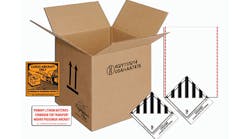If not managed properly, the transportation of inherently-dangerous hazardous or radioactive materials can result in accidents and spills, monetary damages, injury and even death.
About 20 million consignments of all sizes containing radioactive materials are transported worldwide each year on public roads, railways and waterways. According to the Pipeline and Hazardous Materials Safety Administration, in 2016 alone, more than 5,500 incidents occurred during the transportation of hazardous materials, resulting in more than 54 million dollars of damage, 41 injuries and seven fatalities.
In order to move radioactive cargo safely and efficiently, this job requires an immense amount of knowledge and expertise. There are many moving parts to consider when transporting contaminated materials, including insurance and liability, regulatory restrictions, carrier qualifications, safety protocols and more.
Preparation: A Robust Insurance and Liability Plan
If you're working with a third-party logistics provider (3PL), as many shippers do, keep in mind that insurance and liability present unique challenges. In order to transport hazardous waste and/or contaminated materials, there are significant premium increases and regulations that 3PLs need to manage throughout the freight-forwarding quotation process.
There is an important distinction made between actual spent radioactive waste and materials that have been contaminated, such as tools and equipment used in nuclear plants. In order to be certified to transport radioactive waste and/or contaminated materials, 3PLs must retain a special insurance policy dependent upon a class system created by the Nuclear Regulatory Commission (NRC).
When transporting materials that are inherently high-risk, liability is also something that 3PLs and freight forwarders must understand well. If a carrier takes a shipment without the proper documentation, the 3PL is liable, and must be ready to assume responsibility for any fines or damage. The 3PL is also liable for any equipment lost or damaged during transport.
An Unstoppable Safety Regime
With any hazardous material transportation, 3PLs must establish a system of safety protocols to ensure the safety of employees, carriers and the general public.
The majority of hazardous material transportation jobs revolve around utility plants. Before any vehicles and equipment may enter or leave the "gated area" of a plant, it must be searched extensively to ensure there is no trace of contamination. This process can take as little as a few hours or a full day depending on the size of the vehicle and trailer and material transported. Once this process is complete, it's time to hit the road.
The U.S. Department of Transportation (DOT) requires full documentation of all materials traveling on public roads. The only way for the DOT officials to know what is being transported inside a vehicle is by reviewing the shipping manifesto. These documents clearly specify what is being transported through a classification system of words and codes in compliance with the DOT. Shipping manifestos must be readily accessible to the driver and to emergency response personnel at all times. In the event of an accident, emergency officials need to be able to quickly understand the material being transported and take the proper precautionary steps.
After transporting contaminated equipment and unloading materials, the vehicle and equipment must be inspected to ensure there is no residual contamination. This post-transport cleanup process is known as "free release." The vendor conducting the free release cleanup must be certified to do so and has final say as to whether the vehicle and trailer will be released for the next job. Beyond the vehicle and trailer, carriers must have all clothes laundered through a special process that targets and removes hazardous materials and accounts for the safe disposal of water used, keeping the truck driver, his/her family and the surrounding communities safe.
Establishing a Trusted Carrier Network
When handling a contaminated shipment, 3PLs need to thoroughly vet all carriers before enlisting their services. Currently, there's a group of proven, trusted and NRC certified carriers that are tasked with safely hauling contaminated materials.
There are essentially three classes of carriers:
- Common
- Contract
- Private.
Common and contract carriers provide a service to others, carrying other people's materials. Common carriers have published rates for hauling material, while contract carriers negotiate a specific contract with the shipper. 3PLs work with both common and contract carriers.
One of the challenges 3PLs face when trying to transport radioactive materials is finding carriers that transport class 7 shipments. Often, carriers refuse transport equipment with this classification due to the risk involved and lengthy regulatory process.
One way 3PLs choose carriers is by looking at CSA scores. "CSA" stands for Compliance, Safety, Accountability, and is an initiative that was introduced by the Federal Motor Carrier Safety Administration (FMCSA) to improve the overall safety of commercial motor vehicles. Launched in December 2010, the CSA is a safety enforcement program based on carrier performance, driven by the data collected on them.
The CSA program is meant to allow the FMCSA to put a more intense focus on companies that pose the highest safety risks on the roads. The ultimate goal of the CSA program is to make the roads safer for both carriers and the public. To achieve this, both carriers and drivers are held accountable for their role in safety.
So how are CSA scores calculated? A company's safety data is collected from roadside inspections, crash reports, investigation results and registration details. All this data is then made available on the FMCSA's Safety Management System (SMS) website, which is updated on a monthly basis.
The SMS takes into consideration the amount, severity and date of any violations, inspections or the number of crashes in which a carrier has been involved. There is more weight given to violations that are more recent, and after two years violations are removed from the record. Also, crashes are weighted based on severity, so a crash involving a fatality or injury has more impact on the score than one that just required a tow.
The following are all indicators that affect a carrier's CSA score:
- Unsafe Driving—Dangerous or careless operation of a vehicle, including unsafe driving practices like speeding, improper lane changes and failure to wear a seat belt.
- Crash Indicator—History of crash involvement based on state-reported crashes.
- Hours of Service (HOS) Compliance—Incidents of vehicle operation by drivers who are ill, fatigued, or in noncompliance with HOS regulations, including driver log violations.
- Vehicle Maintenance—Mechanical defects and failure to make required repairs, as well as improper load securing.
- Controlled Substance/Alcohol—Impaired driving through the use of alcohol, illegal drugs and misuse of over-the-counter and prescription drugs.
- Hazardous Materials Compliance—Unsafe or incorrect handling of hazardous materials, including leaking containers, improper placarding and missing shipping papers.
- Driver Fitness—Vehicles operated by drivers who are unfit due to lack of training, experience or medical conditions.
Having good CSA scores reduces overall involvement with the DOT, allowing for heightened efficiency. By keeping good scores, carriers can drastically reduce fines and experience less time-consuming roadside inspections.
Working with the Regulators
When transporting hazardous materials, you need to work alongside regulatory agencies and organizations to ensure the overall safety of all parties involved.
The NRC works to protect public health and safety, the environment, and our national security. Proper handling of nuclear materials helps to protect both the safety of the public and the plant workers. To achieve this, the NRC works with the DOT and the Department of Energy (DOE). Together, these agencies help ensure nuclear materials are packaged and transported safely.
The DOT coordinates with the NRC to set rules for the packaging of contaminated materials. The DOT regulates carriers, sets standards for routes, and is responsible for international agreements on the transport of all hazardous materials. Furthermore, every two years, the DOT requires that carriers and 3PLs complete mandatory hazardous training courses to renew their certification.
Angela Eliacostas is president and founder of AGT Global Logistics, which specializes in service to the nuclear, fossil and power industries. AGT Global Logistics is a woman-owned business, certified by the National Woman Business Owners Corp. and the Women's Business Enterprise National Council.




